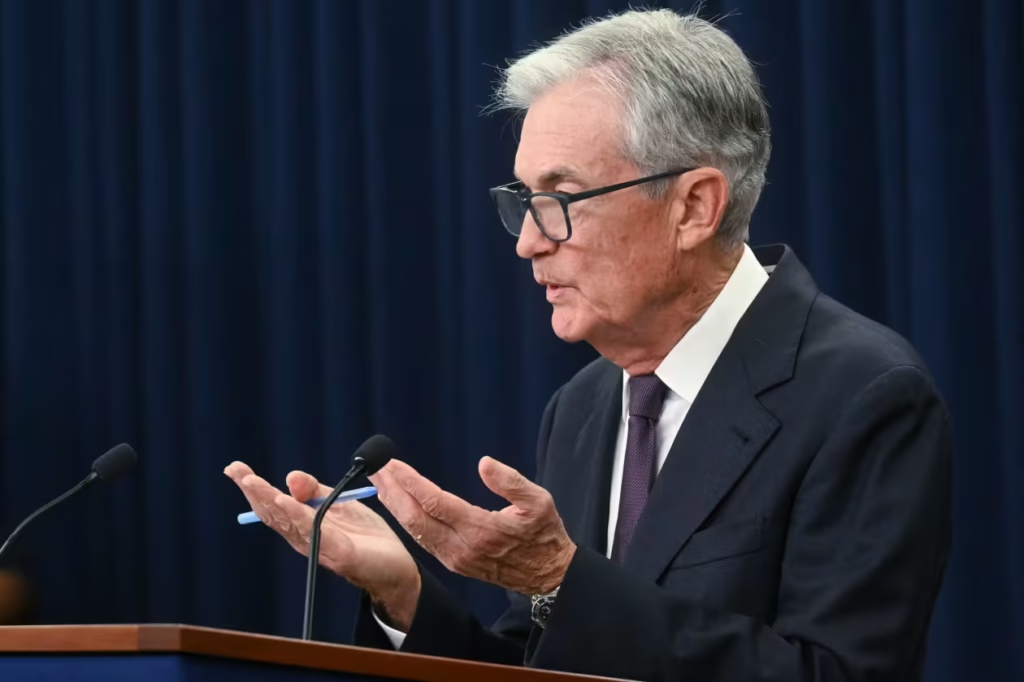Earlier this month, Jerome Powell, the chair of the Federal Reserve, talks during a news conference in Washington.
The possibility that the Federal Reserve may forego an interest-rate cut at its meeting next month has increased due to stronger-than-expected economic data and warnings from important Fed members.
The Fed is attempting to manage an economy that is seeing both increasing inflation and symptoms of a weakening labor market. Although they are monitoring inflation, Fed officials have stated that they are reducing rates in reaction to a worsening labor market.
However, Nancy Vanden Houten, head economist at Oxford Economics, wrote in a research note that the new weekly jobless-claims statistics released Thursday provided some reassurance that labor-market conditions are not becoming worse too much.
The figures, she added, confirm her prediction that the Fed will postpone its next rate cut until December and stay on hold during its meeting on October 28 and 29.
Two voting members of the Fed’s 12-member interest-rate committee voiced some doubt in separate remarks on Thursday on the necessity of further rate drops given that inflation is still stubbornly higher than the Fed’s 2% target.
Jeff Schmid, the president of the Kansas City Fed, stated that the present policy position “is the right place to be.”
“My view is that inflation remains too high while the labor market, though cooling, still remains largely in balance,” he stated.
Austan Goolsbee, president of the Chicago Fed, expressed concern about a rapid rate-cutting spree.
According to Goolsbee, “I’m somewhat uneasy with front-loading too many rate cuts” at a time when the Fed is dependent on inflation being temporary.
Goolsbee stated that he wanted “to be sure” that inflation was declining, pointing out that it had been higher than the Fed’s target for the past five years.
In a speech on Thursday, Fed Governor Michael Barr stated that the Fed’s actions through December were given too much attention, but the larger picture of where rates would go next year was not given enough attention.
“I do believe that lowering rates gradually will be the most sensible course of action, or the base case. He stated, “I simply believe that we must exercise caution in how we accomplish that.”
Barr noted that while the Fed must be careful that the price rises brought on the tariffs do not become ingrained in the economy, inflation may continue to climb in 2026 before gradually declining.
A voting member and president of the St. Louis Fed, Alberto Musalem, stated on Monday that “there is limited room for easing further without policy becoming overly accommodative.”
Derivative market traders reduced their likelihood of a move to 83% from 93% on Wednesday, but they still anticipate an October rate decrease.
The belief that the Fed will soften in October is still held by many economists.
The job market is still in a precarious state, according to Thomas Simons, chief U.S. economist at Jefferies.
An increasing number of businesses are reportedly struggling to avoid cutting employment in order to save labor costs, according to anecdotal reports such as the Fed’s “beige book” poll of company contacts.
“We think the Fed will cut again in October and December by 25 basis points a piece,” Simons stated. According to him, the Fed may decide to wait if there is a government shutdown since there may not be enough economic data.
SGH Macro Advisors head U.S. economist Tim Duy stated that he believes Fed Chair Jerome Powell is in favor of rate decreases in October and December.
According to Duy, regional Fed bank presidents who are apprehensive about further rate decreases should not be taken too seriously by the markets. The seven-member Board of Governors in Washington, he pointed out, is “stacked” with officials who favor rate cuts, and Powell and the other members set the policy direction.
The Fed may pause following the October meetings, according to some economists.
According to Michael Feroli, chief U.S. economist at J.P. Morgan, “we think a major shift in labor market momentum would be needed to prevent another cut in October.”
“However, if labor-market risks don’t materialize in the fourth quarter – particularly in the form of a higher unemployment rate – then the Fed’s interest-rate committee might pause after the October or December meetings,” he stated.
The Fed’s next interest-rate committee meeting is just one day away from the release of the next jobs report.





